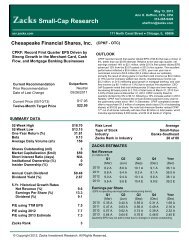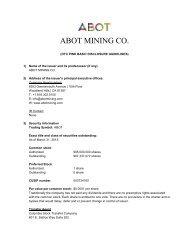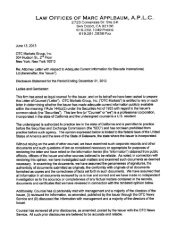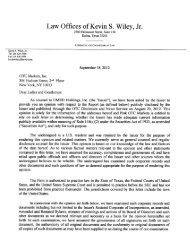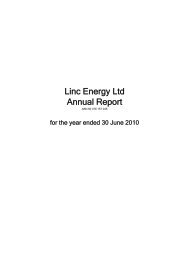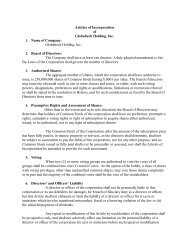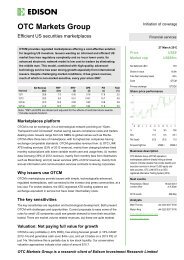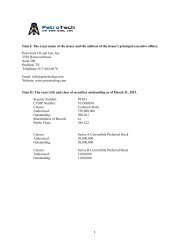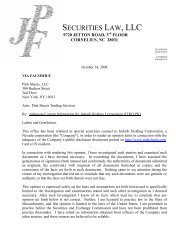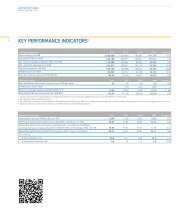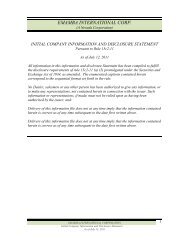2011 Annual Report - OTCIQ.com
2011 Annual Report - OTCIQ.com
2011 Annual Report - OTCIQ.com
You also want an ePaper? Increase the reach of your titles
YUMPU automatically turns print PDFs into web optimized ePapers that Google loves.
The Supervisory Board, at its discretion, determines the<br />
degree to which Board of Management members have met<br />
the targets of the individual-performance portion of their<br />
annual bonus. In making this determination, the Supervisory<br />
Board pays particular attention to the criteria of Section 87<br />
of the AktG and to the Code.<br />
The maximum bonus that can be attained is 200 percent of the<br />
target bonus. The minimum bonus paid is equal to 30 percent<br />
of the target bonus (except in the case of Mrs. Stachelhaus<br />
and Mr. Kildahl, who were appointed to the Board of Management<br />
in 2010).<br />
Thirty percent of the total annual bonus (individual target<br />
attainment multiplied by the value-added factor) is based on<br />
target achievement for the prior financial year (a single-year<br />
performance metric). The remaining 70 percent of the total<br />
annual bonus (EBITDA target attainment multiplied by the<br />
value-added factor) is calculated as follows: Half (that is, 35 percent<br />
of the total annual bonus) is based on the prior financial<br />
year. The other half (that is, the other 35 percent of the total<br />
annual bonus) is a three-year performance metric based on<br />
EBITDA target attainment and the value-added factor for the<br />
previous financial year and the two subsequent years. This<br />
portion of the annual bonus will be calculated and paid out<br />
based on target attainment for the previous financial year.<br />
However, this portion of the bonus is preliminary and is subject<br />
to partial repayment if there are negative developments in<br />
the subsequent years. This portion of the annual bonus is definitively<br />
set at the end of the two-year period following the<br />
baseline year. If the three-year average for target attainment<br />
is higher than the preliminary calculation for the one-year<br />
period, then Board of Management members receive an additional<br />
bonus payment (bonus). If it is lower, they are required<br />
to pay back the resulting difference or have it deducted from<br />
their next bonus (malus or negative bonus).<br />
Since 2010, more than 60 percent of the Board of Management’s<br />
variable <strong>com</strong>pensation (which consists of the annual bonus<br />
and long-term variable <strong>com</strong>pensation) is based on long-term<br />
performance metrics, thereby ensuring that this variable<br />
<strong>com</strong>pensation is sustainable. The sustainability requirement<br />
is also reflected by the fact that the Supervisory Board considers<br />
the criteria of Section 87 of the AktG and the Code when<br />
it determines the individual performance portion of the<br />
annual bonus.<br />
CEO Letter<br />
E.ON Stock<br />
Combined Group Management <strong>Report</strong><br />
Consolidated Financial Statements<br />
Corporate Governance <strong>Report</strong><br />
Supervisory Board and Board of Management<br />
Tables and Explanations<br />
Long-Term Variable Compensation<br />
The long-term variable <strong>com</strong>pensation <strong>com</strong>ponent that Board<br />
of Management members receive is stock-based <strong>com</strong>pensation<br />
under the E.ON Share Performance Plan. The Supervisory<br />
Board decides each year on the allocation of new tranches,<br />
including the respective targets and the number of rights<br />
granted to individual members of the Board of Management.<br />
To ensure that this <strong>com</strong>pensation is sustainable within the<br />
meaning of VorstAG, all performance rights allocated under<br />
the plan since 2010 have a vesting period of four years.<br />
The dependence of this <strong>com</strong>pensation on E.ON’s stock price<br />
serves to bring together management’s and shareholders’<br />
interests and objectives. This effect is enhanced by the requirement<br />
that Board of Management members have to invest in<br />
E.ON stock themselves. The factoring in of an internal valueadded<br />
factor underscores the plan’s close alignment with<br />
the Company’s interests. Payout under the plan only occurs if<br />
minimum internal target parameters, which are set by the<br />
Supervisory Board prior to allocation, are achieved.<br />
Starting with the sixth tranche of performance rights allocated<br />
in <strong>2011</strong>, the value of performance rights is based in part on a<br />
60-day average of E.ON’s stock price and in part on the average<br />
ratio of ROACE to WACC plus, per tranche, a premium stipulated<br />
by the Supervisory Board. If this hurdle is not reached, the<br />
value-added factor is 0 percent, and there is no payout. If<br />
the hurdle is reached, the value-added factor is 75 percent. If<br />
the hurdle is exceeded, a linear function is used to calculate the<br />
value-added factor, which is limited to a 150-percent maximum.<br />
Extraordinary events and changes in E.ON’s portfolio (acquisitions<br />
and disposals of significant assets or government<br />
interventions such as the forced shutdown of some nuclear<br />
power stations in Germany) are not factored into the determination<br />
of the value-added factor.<br />
183



